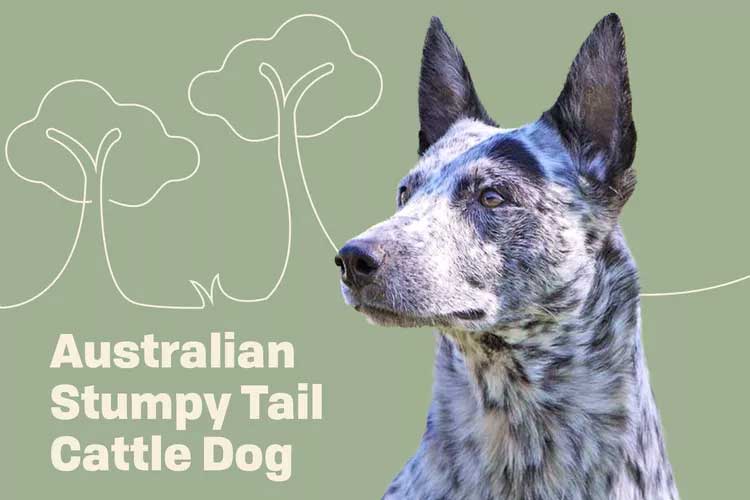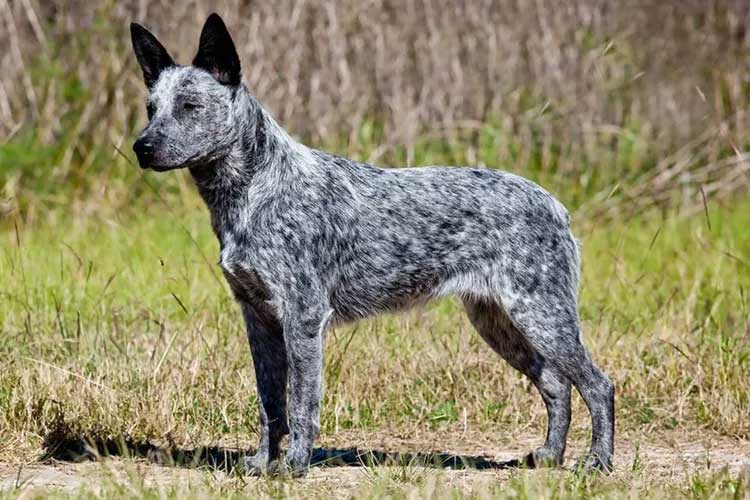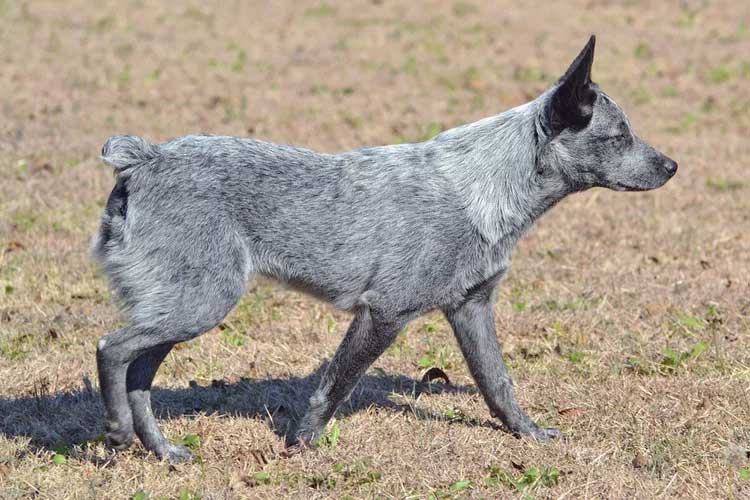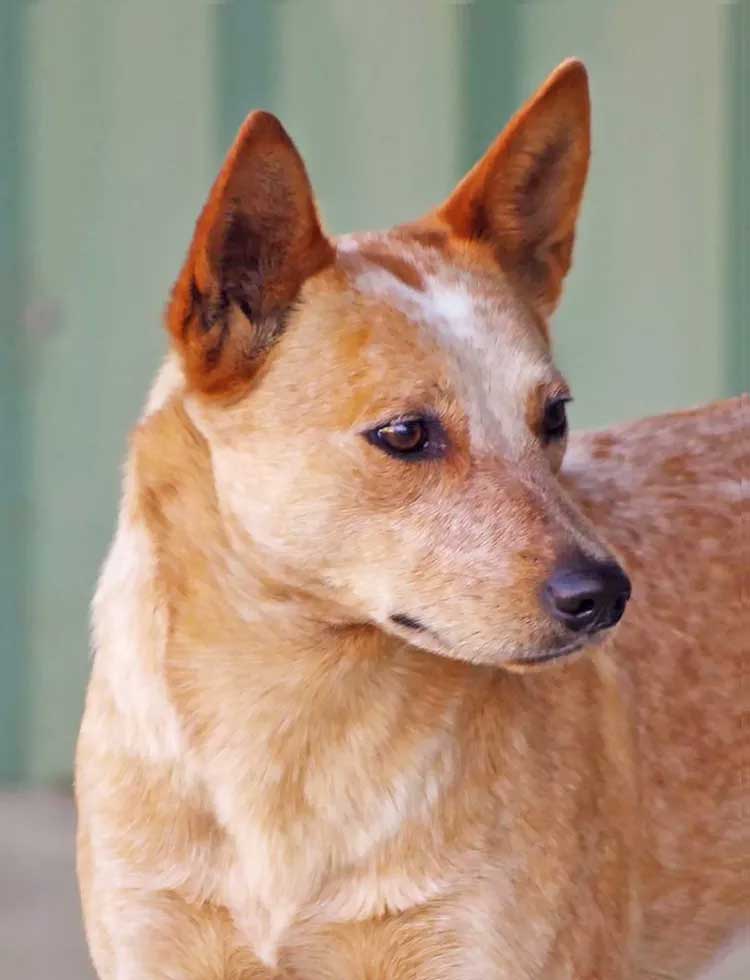The Australian stumpy tail cattle dog is an intelligent and high-energy dog who is loyal and devoted to her owner. Learn more about living with the go-go-go "stumpy."

Australian Stumpy Tail Cattle Dog Overview
| OFFICIAL NAME | Australian Stumpy Tail Cattle Dog |
| COMMON NAME | Australian Stumpy Tail Cattle Dog |
| PET HEIGHT | 17 to 20 inches |
| PET WEIGHT | 32 to 45 pounds |
| LIFESPAN | 12 to 15 years |
| GOOD WITH | children, families |
| TEMPERAMENT | playful, willful |
| INTELLIGENCE | high |
| SHEDDING AMOUNT | normal |
| EXERCISE NEEDS | high |
| ENERGY LEVEL | active |
| VOCAL LEVEL | infrequent |
| DROOL AMOUNT | low |
| BREED GROUP | none |
| BREED SIZE | medium (26-60 lbs.) |
| COAT LENGTH | short |
| COLORS | blue, red |
| PATTERNS | bicolor, flecked / ticked / speckled |
| OTHER TRAITS | good hiking companion, high prey drive, strong loyalty tendencies |
Not to be confused with the Australian cattle dog, the Australian stumpy tail cattle dog is very much her own breed, even if there aren't too many of her around. She's a natural when it comes to working, whether that be out in the pasture with cows or through dog sports. Standing between 17–20 inches at the shoulder and weighing in between 32–45 pounds, the Australian stumpy tail cattle dog is considered to be courageous as well as unwaveringly loyal and devoted to her owner.
As a working dog with high energy levels, the stumpy needs moderate exercise every day to keep her stimulated physically and mentally. If you don't have a pasture of cows for her to manage, she'll be happy going for a run or a hike through the woods, and she excels at dog sports like agility, herding, and obedience.
Appearance
Standing between 17–20 inches at the shoulder and weighing between 32–45 pounds, the Australian stumpy tail cattle dog (affectionately known as a "stumpy") has a double coat. The outer coat is short, straight, and dense; the undercoat is also short and dense, but soft. The breed's coloring can be blue or red. Blue dogs can be mottled or solid in color, and her head and body may have black markings. Red dogs can be speckled, with darker red markings on her head and red patches on her body.
Stumpies get their name from their rear ends; their tails are naturally bobbed (not docked). The breed standard calls for a tail no longer than 10 centimeters, though some stumpies are born with long tails.
It's easy to mistake an Australian stumpy tail cattle dog for an Australian cattle dog. But once you know the differences between the two, you'll be able to tell them apart in no time. Whereas an Australian cattle dog is more rectangular in shape, with a body longer than it is tall, the stumpy is more square, with her body's length equal to her height. Additionally, an Australian cattle dog's ears are set wide apart, and a stumpy's ears are set high on her head, giving her the appearance of always being alert.
Temperament
According to the Australian Stumpy Tail Cattle Dog Society of the U.S., stumpies are energetic, watchful, determined, alert, fearless, loyal, and obedient. The breed is able to fill nearly any role—loving family dog, search-and-rescue hero, agility champion, therapy dog, police and military canine, and farmhand."The stumpy's temperament characteristics derive from the work they were bred to do—herding livestock by nipping at their heels, hence why these cattle dog breeds are sometimes referred to as 'heelers,'" says Stephanie Sheen, DVM, veterinary expert with Fuzzy. "They tend to be a bit standoffish, particularly with strangers, as they were watch dogs on the farm, alerting of possible intruders. However, because they worked one-on-one with their people daily, stumpies tend to bond closely with those few in their inner circle."

Looks aren't the only differences between Australian stumpy tail cattle dogs and Australian cattle dogs. Hyla Burleson, who has owned and worked with stumpies since 1979, says stumpies are more affectionate than their Australian cattle dog counterparts and will be "in your lap, in your face saying, 'let's play, let's cuddle.'"
Stumpies are also "on all the time," Burleson says, and have a higher energy level than ACDs, even when it comes to bedtime.
"An Australian cattle dog will sleep at your feet, but a stumpy will sleep 2–3 feet away from you, ready to go," Burleson says.
With their go-go-go personality, Australian stumpy tail cattle dogs can make wonderful playmates for older kids, though these rambunctious herders might be a little much for families with small children, Sheen says. As with all dogs, make sure puppy playtime is always supervised and that kids know how to properly interact with animals.
Living Needs
As independent workers, stumpies are loyal to their family but might prefer to be the only fur baby at home. Australian stumpy tail cattle dog puppies can live well with cats and other dogs when properly introduced at a young age, but in general these pups want to be your only four-legged friend.Stumpies are high-energy dogs who need lots (like, lots) of physical and mental stimulation. But if you don't have a big fenced-in yard, that's not necessarily a deal-breaker. As long as an owner understands the time commitment Australian stumpy tail cattle dogs require, they can live happily in an apartment, condo, or small home in the suburbs.
"Problems come when there's not enough mental stimulation," Burleson says. "Don't just put them in the backyard and forget about them."

Stumpies need plenty of exercise and tasks to focus on, even if it's just puzzles or interactive toys.
"Because they are intelligent with lots of energy to spare, if they aren't given a task to do they might find one of their own choosing, which can lead to undesirable behaviors," Sheen says. "Stumpies are a working breed and as such have high energy—no couch potatoes here! A family seeking to adopt a stumpy should share an active lifestyle. They are likely to be unhappy as apartment dogs unless given access to long runs daily."
Additionally, her high level of intelligence and impressive physicality means that she can excel at outdoor activities like hiking and running, not to mention dog sports.
"Stumpies are great dogs to consider getting involved in dog sports with, such as agility, flyball, herding, or nose work training," Sheen says.
Care
Aside from providing adequate mental and physical stimulation, caring for your Australian stumpy tail cattle dog is fairly easy. She doesn't require a lot of grooming. In fact, grooming is minimal: A weekly brushing with a slicker and small tooth comb will suffice in keeping her coat in good condition, and she only needs bathing when dirty.As with all dogs, take the time at home to ensure your stumpy's ears are free of infection, her teeth are brushed often, and her nails are trimmed.
With their smarts and loyalty, stumpies take to training well, especially when they have a routine to follow. Burleson says establishing a routine is the first thing to do when you bring home an Australian stumpy tail cattle dog puppy. For example, when you walk out the front door, have your stumpy sit until you've cleared the doorway and are ready to go. Like all dogs, consistent and positive reinforcement training throughout her life will help your stumpy be polite and well-behaved.
Health
Stumpies have a lifespan of 12–15 years and are generally healthy dogs. But, as with all dogs, pet parents need to stay vigilant for a few health concerns."Deafness does run in the breed, so all puppies should be BAER hearing tested," Sheen says. She adds that inherited eye issues also can be a problem, so potential breeding pairs should be DNA tested for progressive retinal atrophy and primary lens luxation before breeding.
Talk to your veterinarian if you notice any changes in your pup. Aside from these potential conditions, your Australian stumpy tail cattle dog should visit the vet for regular checkups and vaccinations.
History
According to the Australian Stumpy Tail Cattle Dog Society of the U.S., stumpies are believed to be the first breed developed in Australia. Stumpies, along with Australian cattle dogs, are thought to be descended from two types of working dogs that were developed around the 1840s.Though stumpies were never high in numbers, the breed's population declined further after World War I, and the breed was nearly extinct by the 1980s. The Australian National Kennel Council made efforts to save the breed, and numbers are growing as more people become aware of these versatile dogs.
Fun Facts
Didjah, a 5-year-old stumpy, appeared in the 2011 movie Thin Ice.Though the Australian stumpy tail cattle dog was the first dog breed developed in Australia, the pups didn't make their way to the U.S. until after World War II.